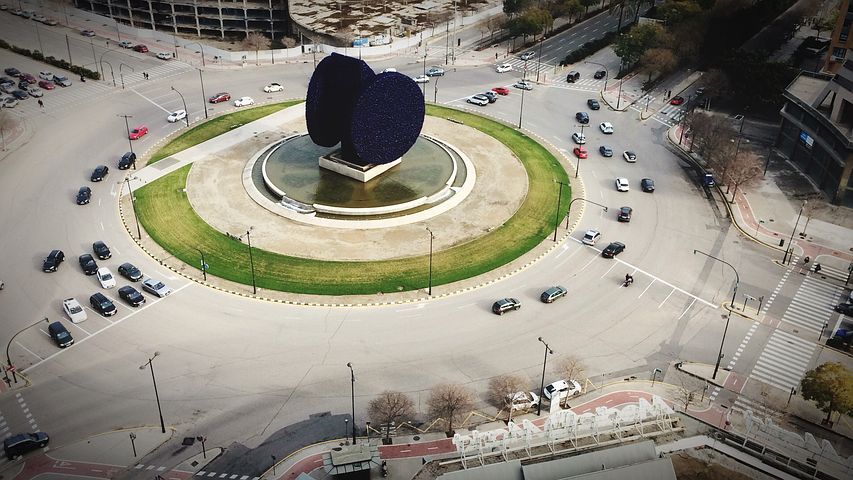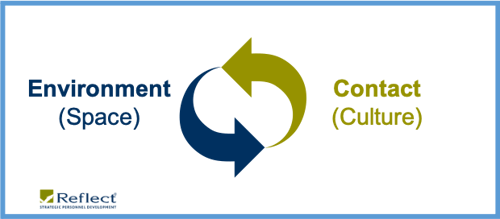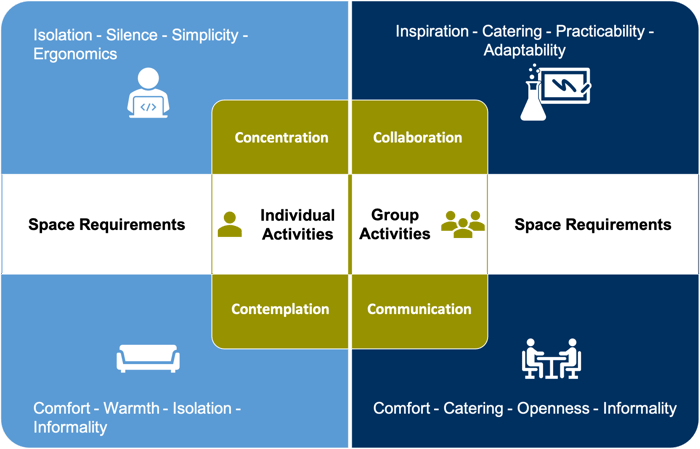From single-office to multispace
Why offices have a future and how you can benefit from Workplace Change.
The rise of the multispace - the solution to enable collaboration, creativity and focus in the workplace
The transformation of workspaces has accelerated rapidly as a result of the pandemic. Millions of workers and thousands of employers have realized that the home office is a better alternative to the office than previously expected.
Many companies we speak with recognize the benefits of the home office for focused, individualized work, while at the same time noticing that creativity and innovativeness suffer from the Corona Crisis due to a lack of human contact and despite all digital efforts. But what happens when workers* return to the office? Will productivity decrease and creativity increase?
In the spatial concepts of the New Work movement, the two aspects mentioned above are combined. The office becomes an environment for concentrated work, individual relaxation, creative collaboration, and analog and virtual communication. A place where employees have the right space for every activity: The Multispace.
Companies that already rely on a multispace room concept will welcome their employees after the pandemic with the opportunity to combine the tranquility of a home office with the dynamics and interaction of an office in one place. Organizations that have not yet adopted multispace: Pay attention! Otherwise, you will miss out on one of the most important current changes in the world of work, and with it the chance to reap the economic and cultural benefits that a multispace brings.
Why is "space" an important lever for performance and corporate culture?
How often do you come into your office and consciously look around: "Does the architecture, the room design still fit the way we work here?" Most of the time, we live and work in our offices so naturally that the familiar surroundings receive no attention. In the search for efficiency and performance potential, we turn over every process and every structure ...and forget one dimension with a formative influence on performance, on motivation, on corporate culture, on employee loyalty: Space.
The spaces in which we grow up, in which we learn, in which we work and live, shape us and our interaction with our fellow human beings. Cultures and subcultures emerge in the context of space and time and are shaped by these two dimensions. At the same time, spaces also reflect cultures - they are thus both an influence on and an artifact of a culture.
Think of the TV series Stromberg: the Capitol insurance company with its open-plan office for clerks and the large corner office for the department head shape the culture - the corner office and also the anteroom are cultural artifacts that are strived for because they represent and manifest power and influence. At the same time, the office spaces are also the result and expression of a culture - in this case, a very sluggish, bureaucratic, transactional, and political culture that is reflected in the corner offices, the anonymous hallways, the small smoking booth, and the gray facade.
As a regular reader of our notes, you of course know what an enormous impact corporate culture, ergo space, has on employee motivation, retention, health and performance. At the same time, you also know how difficult it is to change the basic assumptions and values of cultures - in comparison, spaces are relatively easy to change and thus represent a valuable lever for cultural change - after all, they can make the change visible through new artifacts and influence the deeper cultural dimensions.

Beware of the "mismatch" between office space and corporate culture
The interaction between space and culture is also so interesting because, as transformation facilitators, we find a "mismatch" between space and culture in many companies. There are 2 extremes here, neither of which is healthy for a company in the long run:
Modern space - conservative culture:
The top managers of the company have understood how important space is for the development of an innovative and agile corporate culture. So they invest in new premises, make everything a bit more colorful and open, and discover that the employees do not accept the rooms. On the contrary, cynicism dominates the hallway conversations, the expensive new offices are laughed at - things go on as usual and the employees put up with the many whiteboards and "chillout areas" - as long as they have their desk safe. Secretly, they are eyeing the beautiful corner offices of the executives anyway.
Conservative space - modern culture:
A new organizational unit is created - and a place is found for it, namely in the practical offices from the 80s that have been unused for a few months. The agile newcomers are horrified, but try to make the space their own, hanging posters, placing boards and handing out beanbags. But after a few weeks, the cramped, gray space "stifles" the energy. The two- and four-person offices turn every workshop and scrum meeting into a compromise - the "inhabitants" get used to the circumstances and settle in.
These two examples clearly show that culture and space change must go hand in hand. We call this Workplace Change - and offer you exactly the holistic transformation support that is needed to pull both levers at the same time and thereby
... create a space that promotes the target culture and
... create a culture that "brings the space to life",
in other words, creating a "match" between the space and the target culture.
For a more detailed reading on Workplace Change, we also recommend our whitepaper, in which we explain how space and culture change pave the way to a Healthy Organization
Why are multispace environments the spatial solution for the future of work?
The New Work movement and the digital transformation teach us: work will increasingly center on knowledge work in the future. Automation and robotics will take over large parts of what can be measured and calculated. Human work will move beyond routines to focus on solving complex problems, creative product development and unfolding new strategies. Work will become more demanding. Is your office space already responding to this future? The office will be
- the key space for innovation
- the place where people develop and live out their cognitive, emotional and creative potential
- an environment that encourages exchange and communication and at the same time also enables concentration and reflection.
In essence: In the future, it will depend - more than anything else - on people and their ability to be creatively and cooperatively effective! This can be achieved in offices that are designed with the future in mind and enable people to develop. And in order to develop, office spaces must offer a home to different working modes. After all, every person is different, has personal preferences and unfolds his or her potential in an individual way. The space that should make this possible is the so-called multispace, which we will now explain in more detail and which, according to a Fraunhofer study, will be the most widespread form of office in the future.
What exactly does Multispace mean - and is there a difference to Activity Based Working?
A multispace working environment is characterized by the following factors:
Combination of rooms with different purposes: rooms for teamwork, telephone calls, concentration or relaxation are designed differently according to purpose. In contrast to an open-plan office or "open space", a multispace has, among other things, real spaces for retreat.
Parallel availability of rooms for employees according to their needs: employees choose the working environment they currently need. The Multispace thus supports a modern view of people, according to which employees decide for themselves which framework conditions they need.
Free choice of space/flexible workplaces: Multispace describes a non-territorial office concept in which employees usually do not have a fixed workstation.
Activity Based Working (AWB) is the way of working in a Multispace. If Multispace describes the spatial concept, Activity Based Working describes the working method and culture, according to which employees can select a suitable space for this specific activity.
The 4 Categories of Activity Based Working
Activities in the office can be divided into 4 categories, the so-called 4 C's - with each activity requiring a suitable working environment.

Concentration:
This category describes activities in which individual employees work in a focused manner. For this, they need visual and acoustic isolation, a sober working environment and ergonomic furniture.
Contemplation (reflection):
Contemplation refers to quiet reflection, retreat, catching one's breath and resting. Comfortable furniture, warm colors and light as well as a protected and informal environment that employees can use individually help here. This is where people recharge their batteries, find energy and focus - e.g. before or after meetings.
Collaboration:
The collaboration category encompasses all activities in which groups work together on a common end product. For collaboration to be effective, efficient and creative, teams need spaces where they can give free rein to their ideas and express themselves, e.g. on flipcharts, (smart) boards or writable walls. These spaces need to be inspiring, provide catering for longer sessions, practical collaboration and documentation options, and be adaptable so that different (project) teams can use the space.
Communication:
Communication includes formal and informal sharing activities, both 1:1 and in larger groups. This means hallway conversations, joint lunches, but also meetings and confidential conversations are assigned to this category. A good communication atmosphere is characterized by comfort and catering facilities. Informal communication in groups in particular also benefits from generously sized rooms and a casual environment (e.g., a large break room with a kitchen and table soccer).
What are advantages of multispace room concepts?
According to the Fraunhofer study "Effective office and work environments" from 2018, multispace environments offer the most opportunities for retreat compared to single offices and other office forms. In addition, the factors "lived collaboration," "learning culture" and "self-determination" are more pronounced in multispace. This is particularly interesting for our economically minded readers: Their employer attractiveness benefits from Multispace. Respondents to the study rated the attractiveness of companies with Multispace environments higher, in part because hierarchical structures are less or not at all reflected in spatial structures. And perhaps more importantly, the two researchers found that multispace office environments contribute more to the implementation of corporate goals (e.g., support for work processes, well-being, innovativeness, sustainability) compared to other office forms.
We also see in transformations towards multispace environments an improvement of collaboration and networking and at the same time focus. As founders of the Healthy Organization, we also recognize in Multispace environments a key to potential development on the employee and company level - since people can work here in a self-determined manner.
Many companies also hope that the switch to a multispace will lead to more efficient use of space and higher employee productivity. However, there is still a lack of studies that examine this connection in greater detail. We assume, however, that new insights into the advantages of Multispace will be gained after the Corona crisis - and we will keep you informed.
Conclusion
More than ever, offices are under scrutiny. And never before has it been so strongly questioned whether offices still have a future - or whether this will belong to purely virtual forms of organization. If it is up to us and many experts and managers with whom we are in contact, offices do have a future! On the condition that they reflect the future of work.
In order to reflect this future, a workplace change is necessary in the vast majority of companies - and this means that culture and space change go hand in hand. And this means that culture and space change go hand in hand in the direction of Multispace - the space concept that offers people the variability of environments that they need every day in order to shape their "work-life" in a balanced, self-determined, focused, creative way and in social contact with their colleagues.
In multispaces, people can find a spatial working environment in which they can be "more human" than in individual, group or open-plan offices. And ultimately, employers also benefit: Through a stronger employer brand, through a space that better supports the achievement of corporate goals, through motivated, self-determined employees* and who knows ... probably even through higher productivity.
Embedding transparency into a corporate culture is most easily accomplished by management and HR leaders. This is where the seeds can be sown that will ensure trust, fairness and openness, and which will then be watered and further developed by all members of the organization.
Literature:
Haner, Udo, Ernst; Wackernagel, Stephanie (2018) ORGATEC Special Report on the Study "Effective Office and Working Environments", Fraunhofer IAO.

